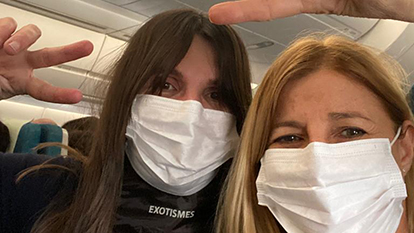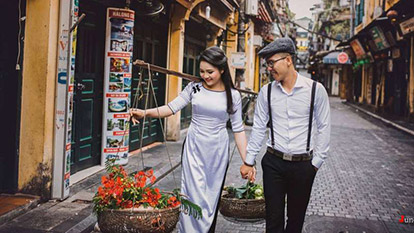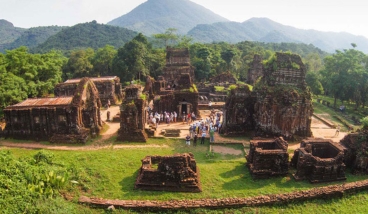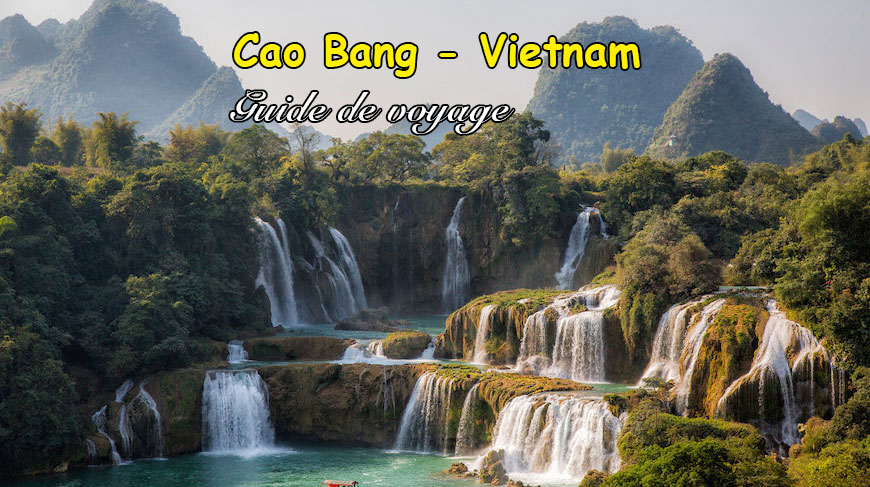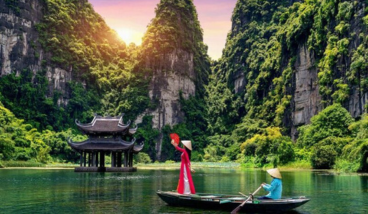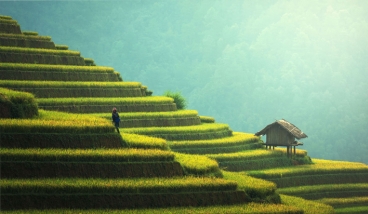Vietnam Population & Religions
13/04/2019 1.637 Views
On the eastern tip of the Indochina peninsula in southeast Asia, Vietnam is one of the larger and more densely populated countries in the region. Vietnam's major religions are Buddhism and Catholicism, although the largest percentage of the population follows Vietnamese folk traditions or identifies as non-religious.
Vietnam Population
- Close portrait of a Hmong woman Recent census estimates the population of Vietnam at beyond 86 million (2008). Vietnamese people, also called "Viet" or "Kinh", account for 86.2% of the population. Their population is concentrated in the alluvial deltas and coastal plains of the country.
- A homogeneous social and ethnic majority group, the Kinh exert political and economic control.
- There are more than 54 ethnic minority groups throughout the country, but the Kinh are purveyors of the dominant culture. Most ethnic minorities, such as the Muong, a closely related ethnic of the Kinh, are found mostly in the highlands covering two-thirds of the territory. travel vietnam.
- Before the Vietnam War, the population of the Central Highlands was almost exclusively Degar (over 40 hill tribal groups).[citation needed] The Hoa (ethnic Chinese) and Khmer Krom are mainly lowlanders.
- The largest ethnic minority groups include the Hmong, Dao, Tay, Thai, and Nung. From 1978 to 1979, some 450,000 ethnic Chinese left Vietnam.
Religion of Vietnam
- In Vietnam, little is what it appears to be on the surface. The country’s religion is an excellent examboudismeple. Ostensibly, Vietnam is a Buddhist country – around 80% of the population regard themselves as adherents. Pagodas are everywhere, and the Buddhist festivals are embedded in the calendar. Also evident are temples with large effigies of obviously non-Buddhist deities and historical figures, Christian churches and signs of other religious sects.
- Visitors often correctly assume that, as in their own country, several religions are practiced in Vietnam. However, in most countries people commit themselves to a specific religion, sect or cult. In Vietnam, people subscribe to several different canons of beliefs simultaneously.
The triple religion
- The bedrock of religious practice in Vietnam is an amalgam of several components. The major religious inheritance from China, Confucianism, Taoism and ancestor worship, have coalesced with ancient Vietnamese animism to form a single entity – ‘tam giao’ – the ‘triple religion’. Each element exists in a pure form in Vietnam, and there are sects and cults that adhere to a single set of beliefs, but the great majority of people describe themselves as ‘Buddhist’, a portmanteau term for the ‘tam giao’.
- Vietnam’s major religions are described separately in this section, but it must be noted that many of the orthodoxies referred to have been adapted to ‘fit’ the way of life, rather than the other way round. For example, although Mahayana Buddhism requires its followers to abstain from eating meat, Vietnamese Buddhists (apart from monks and other acolytes) avoid meat only on two days each month, the full and the new moon. People arriving with a belief that vegetarianism will be widespread are dismayed to find that this is not so.
Christianity in Vietnam
- Of the major religious faiths present in Vietnam, the Catholics adhere most closely to their creed. Hocatholicismewever, many still maintain an altar in their houses to worship the ancestors, or use a Christian shrine for the same purpose.
- The Catholic Church has been prominent in Vietnam’s recent history. Initially, little notice was taken of European missionaries entering Vietnam from the 16th century onwards. However, when Christianity began to gain a foothold, the mandarins and other authorities increasingly saw it as a threat to Confucianism and banned the religion. The French invaded and gave Catholicism preferential treatment, a policy extended to suppression of Buddhism by the Catholic-led Saigon regime after the country was partitioned. Thich Quang Duc, a Buddhist priest from Hue, publicly burned himself to death in protest in 1963. A graphic photograph of the event had a major impact in turning public opinion against the US presence in Vietnam.
The post-war years
- After re-unification, the communist authorities followed Marx’s dictum that religion was ‘the opiate of the people’ and introduced controls on religious expression by placing religion under state control, confiscating land and property, and sending priests, monks and other devotees who had been politically active supporters of the Saigon regime for ‘re-education.
- Since ‘doi moi’ opened Vietnam to the rest of the world in 1986, restrictions have eased, land has been returned and religious freedom has been enshrined in the nation’s constitution. Nevertheless, although the vast majority of the people are now free to worship more or less what and where they like, the authorities continue to keep a firm hold on religion and its more fervent followers, mindful of attempts by Vietnam’s political enemies abroad to use it to foment dissent.
- From time to time, critical reports are issued by religious and political organisations in the West, claiming this as suppression of freedom and abuses of human rights, an accusation vigorously denied by the Vietnamese and by many senior Vietnamese clerics. In reality, the Vietnamese government has recognised the destabilising potential of ‘social evils’ such as drug abuse and crime, and is encouraging religion and religious values as a contribution towards maintaining social cohesion at a time of rapid development.
ONLY WITH US : 100 % MONEY BACK GUARANTEE within 10 days from the date of booking if not satisfied.
For further information, or simply a free quote, please contact us at any time via our email: info@galatourist.com, our experienced consultants will reply to you within 48 hours.Sincerely yours & see you soon!
GALATOURIST since 2005.
Related Articles
Coronavirus situation by traveller in Vietnam on February 4, 2020
Coronaviruses are a large family of viruses, which cause illnesses ranging from a simple cold (some seasonal viruses are coronaviruses) to more severe conditions such as MERS or SARS. The virus identified in Wuhan in December 2019 is a novel coronavirus. It was named 2019-nCoV.
Top 29 best places to visit in Hanoi Vietnam
As the capital of Vietnam, Hanoi still retains its leisurely pace in a quiet atmosphere compared to the more bustling Ho Chi Minh City. However, Hanoi deserves to be the capital of Vietnam thanks to its typical culture accumulated along the passage of time which defines best what Vietnam is. The article will show you 29 best places to visit in Hanoi for your choices.
What to do in Da Nang ? Visit My Son Sanctuary Da Nang
About 60 kilometres from Da Nang, in a narrow valley surrounded by steep, verdant hills, the My Son sanctuary is an attraction not to be missed by anyone who wants to explore some of the most famous cultural sites in Viet Nam. This world heritage site used to be one of the chief religious sites in the kingdom of Champa. However worn down by centuries and civil war, these red brick temple ruins retain a sacred, enigmatic quality. Visiting My Son Sanctuary, you will be drawn back to olden times, imagining how people could construct such a temple under the control of primitive tools and construct materials. If you’re asking yourself what to do at Da Nang other than the beach, this cultural escape is a genuine escape from our current time that would be a shame to miss.
Top 6 best homestays in Tha Village Ha Giang
Tucked away in the serene hills just 3–5 kilometers from Ha Giang city, Tha Village is a peaceful little world in which nature and culture closely intertwine. Bounded by vast mountains, golden rice fields and meandering streams, this Tay ethnic village will allow you to have a genuinely Northern Vietnamese countryside experience. Come harvest time, the landscape transforms into a golden wonderland that has postcard - worthy views. Visitors are warmly welcomed by the friendly Tay people and can observe or join in daily activities such as traditional cooking, weaving, or folk singing. Looking for where to stay in Tha Village ? With cozy homestays throughout, there are top 6 best homestays in Tha Village that not only offer comfort but the chance to live like a local. This is much more than a place to stay; it is an authentic cultural experience far off the beaten track.
Complete Travel Guide to Cao Bang Vietnam
Are you planning to travel to Cao Bang, a land blessed by nature with the breathtaking beauty of majestic mountains, picturesque landscapes, and fresh, pure air? Here is our complete travel guide to Cao Bang, along with practical tips to help you better prepare for your visit to this wild and unspoiled region in the northwest of Vietnam.
Best Time To Travel Vietnam
When is the best time to travel to Vietnam? Vietnam is a country of breathtaking diversity, both in climate and culture, offering unforgettable experiences every month of the year. From the cool, misty mountains of the northern highlands to the sunny beaches of the central and southern coasts, each region has its own weather patterns and seasonal highlights. Whether you're planning a trekking trip in Sapa, a cultural journey in Hoi An, or a beach vacation in Phu Quoc, timing can make all the difference. Galatourist helps you discover the best time to visit Vietnam based on your interests, preferred destinations, and weather conditions. With expert tips and detailed guides, you can confidently plan a personalized itinerary for the most rewarding travel experience in Vietnam.
Explore Hoang Su Phi rice terraced fields - Vietnam iconic landscape
Terraced rice fields are one of the breathtaking wonders shaped by both nature and human hands — a truly unique form of cultivation that can only be found in Vietnam. Among the most iconic landscapes, the Vietnam terraced rice fields in Hoang Su Phi are a top destination, especially during the stunning golden rice season. The Hoang Su Phi rice terraced fields, with their layered golden waves cascading down the mountains, attract thousands of local and international visitors each year. However, reaching and exploring these scenic rice terraces can be quite challenging for those who are inexperienced or unprepared. To help you make the most of your trip, we’ve compiled some practical travel tips for Hoang Su Phi that will guide you through a smooth, safe, and unforgettable adventure in one of Vietnam’s most breathtaking rural regions.
Pu Luong Travel Guide Vietnam A to Z
Surrounded by lush forests, rolling hills, and cascading rice terraces, Pu Luong Vietnam invites you to reconnect with what truly matters. Whether you're seeking quiet contemplation, exciting adventures, or meaningful moments with friends and family, this destination has something for everyone. Our Pu Luong travel guide below will provide you with all the essential information, tips, and inspiration to plan a memorable trip this week. From scenic hikes and refreshing streams to cultural encounters with ethnic minorities, Pu Luong offers a magical blend of serenity and exploration.
Foodtour in Chinatown Saigon
When mentioning Saigon Chinatown, people will immediately think of Chinatown in the 5th District, where many architectural works of Assembly Halls and pagodas with ancient Chinese architecture are concentrated, and especially, this is also the place where many traditional Chinese restaurants can make your taste buds explode. From famous dishes such as dimsum, roast duck, duck braised noodles to Chinese sweet soup, egg tarts, Chinatown Ho Chi Minh brings a complete experience for tourists who love to explore East Asian culture.
Best season to visit Ben Tre Vietnam
When is the best time to travel to Ben Tre? Learn about Ben Tre’s climate characteristics and choose the ideal time to discover the charm of its rivers, fruit gardens, and vibrant folk festivals. We hope the article below will help you plan your Ben Tre trip according to your schedule and personal preferences!
Travel guide to Ba Be National Park Vietnam in Bac Kan province
Ba Be National Park in Bac Kan stands out with its limestone mountains, the largest freshwater lake in Vietnam, diverse ecosystems, and distinctive ethnic cultures. From boating and trekking to exploring caves and traditional villages, it is an ideal destination for those who love nature and want to experience unique local culture.
What to do in Ba Be Lake ? Best things to do in Ba Be Bac Kan
If you're looking for an unspoiled ecotourism destination where forests, mountains, rivers, and authentic local culture come together, then Ba Be Lake, a true "green jewel" nestled in the heart of Vietnam’s northeastern mountains – is a must-visit. Located in Ba Be National Park, Bac Kan province, this is the largest natural freshwater lake in Vietnam, promising unforgettable travel experiences.
Testimonials
The following are the real customer reviews about GalaTourist by video clips, email & feedback form, etc... please check it out!

Ms. Francesca Tronconi & Mr Vizzolini Davide (2pax) from Spain
Ms. Francesca Tronconi & Mr Vizzolini Davide from Spain, taked a Tour in Vietnam on 8.2018

Mrs & Mr. DUPUIS (2pax) from United States
Mrs & Mr. DUPUIS from US taked a vacation of THAILAND & CAMBODIA & VIETNAM 14 days on 3.2018

Mr. Jeffrey Szymanski (2pax) from United States
They taked a trip of Vietnam and Cambodia 11 days on 3.2018

Mrs Rosemary McGuinness (2pax) from Australia
Taking a trip of Vietnam & Cambodia 14 days on 26th mars 2018

Mrs Elena Maria Sanchez (2pax) from Spain
Mrs Elena Maria Sanchez from Spain taked a trip in Vietnam on 1.2016

Group Marissa (4pax) from United States
Group Marissa 4pax from USA taked a Trip in Vietnam on 2.2016

Mr Jerzy (2pax) from Canada
Mr Jerzy from Canada have traveled in Vietnam on 3.2016

Mr Ricardo Velasco (8pax) from Argentina
Sr Ricardo Velasco 8pax - Argentina taked a trip to Vietnam Cambodia Thailand on 2016.




